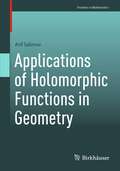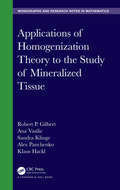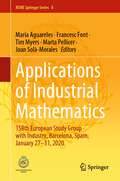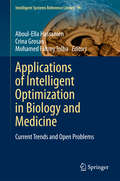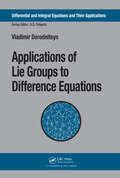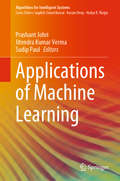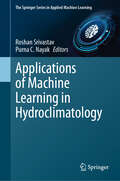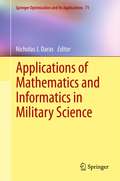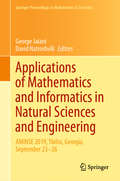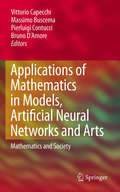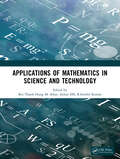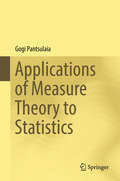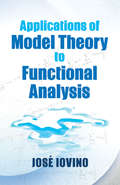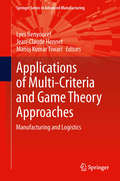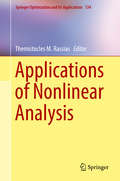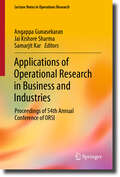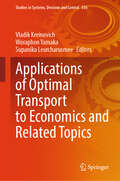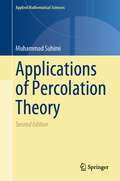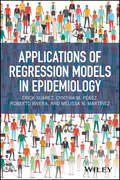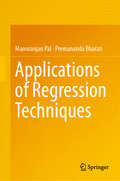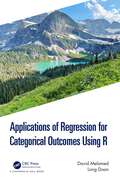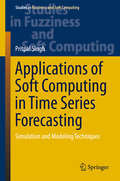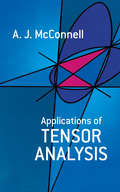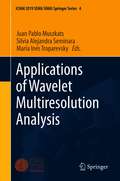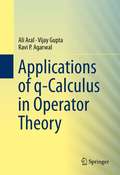- Table View
- List View
Applications of Holomorphic Functions in Geometry (Frontiers in Mathematics)
by Arif SalimovThis book expounds on the recent developments in applications of holomorphic functions in the theory of hypercomplex and anti-Hermitian manifolds as well as in the geometry of bundles. It provides detailed information about holomorphic functions in algebras and discusses some of the areas in geometry with applications. The book proves the existence of a one-to-one correspondence between hyper-complex anti-Kähler manifolds and anti-Hermitian manifolds with holomorphic metrics, and also a deformed lifting to bundles. Researchers and students of geometry, algebra, topology and physics may find the book useful as a self-study guide.
Applications of Homogenization Theory to the Study of Mineralized Tissue (Chapman & Hall/CRC Monographs and Research Notes in Mathematics)
by Klaus Hackl Robert P. Gilbert Ana Vasilic Sandra Klinge Alex PanchenkoHomogenization is a fairly new, yet deep field of mathematics which is used as a powerful tool for analysis of applied problems which involve multiple scales. Generally, homogenization is utilized as a modeling procedure to describe processes in complex structures. Applications of Homogenization Theory to the Study of Mineralized Tissue functions as an introduction to the theory of homogenization. At the same time, the book explains how to apply the theory to various application problems in biology, physics and engineering. The authors are experts in the field and collaborated to create this book which is a useful research monograph for applied mathematicians, engineers and geophysicists. As for students and instructors, this book is a well-rounded and comprehensive text on the topic of homogenization for graduate level courses or special mathematics classes. Features: Covers applications in both geophysics and biology. Includes recent results not found in classical books on the topic Focuses on evolutionary kinds of problems; there is little overlap with books dealing with variational methods and T-convergence Includes new results where the G-limits have different structures from the initial operators
Applications of Industrial Mathematics: 158th European Study Group with Industry, Barcelona, Spain, January 27–31, 2020 (RSME Springer Series #8)
by Tim Myers Francesc Font Maria Aguareles Marta Pellicer Joan Solà-MoralesThis book collects the results presented at the 158th European Study Group with Industry, which took place at the Centre de Recerca Matemàtica in Barcelona in January 2020. The European Study Groups with Industry are a well-recognised forum where mathematicians work with industrial representatives on issues of current interest to companies. At this particular meeting, the problems were chosen to provide a wide variety of subject areas and to appeal to local academics. In this work, the research carried out and the solutions presented to the companies are detailed. In particular, the book focuses on: estimating the difficulty level of mobile games; modelling the stability of human towers; fibre coating in the manufacture of clutch components; safe trajectories of robot arms. The book provides an excellent addition to the canon of Industrial Mathematics. It is addressed to researchers keen to apply mathematics to topical, real-world problems.
Applications of Intelligent Optimization in Biology and Medicine: Current Trends and Open Problems (Intelligent Systems Reference Library #96)
by Aboul-Ella Hassanien Crina Grosan Mohamed Fahmy TolbaThis volume provides updated, in-depth material on the application of intelligent optimization in biology and medicine. The aim of the book is to present solutions to the challenges and problems facing biology and medicine applications. This Volume comprises of 13 chapters, including an overview chapter, providing an up-to-date and state-of-the research on the application of intelligent optimization for bioinformatics applications, DNA based Steganography, a modified Particle Swarm Optimization Algorithm for Solving Capacitated Maximal Covering Location Problem in Healthcare Systems, Optimization Methods for Medical Image Super Resolution Reconstruction and breast cancer classification. Moreover, some chapters that describe several bio-inspired approaches in MEDLINE Text Mining, DNA-Binding Proteins and Classes, Optimized Tumor Breast Cancer Classification using Combining Random Subspace and Static Classifiers Selection Paradigms, and Dental Image Registration. The book will be a useful compendium for a broad range of readers--from students of undergraduate to postgraduate levels and also for researchers, professionals, etc. --who wish to enrich their knowledge on Intelligent Optimization in Biology and Medicine and applications with one single book.
Applications of Lie Groups to Difference Equations (Differential and Integral Equations and Their Applications)
by Vladimir DorodnitsynIntended for researchers, numerical analysts, and graduate students in various fields of applied mathematics, physics, mechanics, and engineering sciences, Applications of Lie Groups to Difference Equations is the first book to provide a systematic construction of invariant difference schemes for nonlinear differential equations. A guide to methods
Applications of Machine Learning (Algorithms for Intelligent Systems)
by Prashant Johri Sudip Paul Jitendra Kumar VermaThis book covers applications of machine learning in artificial intelligence. The specific topics covered include human language, heterogeneous and streaming data, unmanned systems, neural information processing, marketing and the social sciences, bioinformatics and robotics, etc. It also provides a broad range of techniques that can be successfully applied and adopted in different areas. Accordingly, the book offers an interesting and insightful read for scholars in the areas of computer vision, speech recognition, healthcare, business, marketing, and bioinformatics.
Applications of Machine Learning in Hydroclimatology (The Springer Series in Applied Machine Learning)
by Roshan Srivastav Purna C. NayakApplications of Machine Learning in Hydroclimatology is a comprehensive exploration of the transformative potential of machine learning for addressing critical challenges in water resources management. The book explores how artificial intelligence can unravel the complexities of hydrological systems, providing researchers and practitioners with cutting-edge tools to model, predict, and manage these systems with greater precision and effectiveness. It thoroughly examines the modeling of hydrometeorological extremes, such as floods and droughts, which are becoming increasingly difficult to predict due to climate change. By leveraging AI-driven methods to forecast these extremes, the book offers innovative approaches that enhance predictive accuracy. It emphasizes the importance of analyzing non-stationarity and uncertainty in a rapidly evolving climate landscape, illustrating how statistical and frequency analyses can improve hydrological forecasts. Moreover, the book explores the impact of climate change on flood risks, drought occurrences, and reservoir operations, providing insights into how these phenomena affect water resource management. To provide practical solutions, the book includes case studies that showcase effective mitigation measures for water-related challenges. These examples highlight the use of machine learning techniques such as deep learning, reinforcement learning, and statistical downscaling in real-world scenarios. They demonstrate how artificial intelligence can optimize decision-making and resource management while improving our understanding of complex hydrological phenomena. By utilizing machine learning architectures tailored to hydrology, the book presents physics-guided models, data-driven techniques, and hybrid approaches that can be used to address water management issues. Ultimately, Applications of Machine Learning in Hydroclimatology empowers researchers, practitioners, and policymakers to harness machine learning for sustainable water management. It bridges the gap between advanced AI technologies and hydrological science, offering innovative solutions to tackle today's most pressing challenges in water resources.
Applications of Mathematics and Informatics in Military Science (Springer Optimization and Its Applications #71)
by Nicholas DarasAnalysis, assessment, and data management are core tools required for operation research analysts. The April 2011 conference held at the Helenic Military Academy addressed these issues with efforts to collect valuable recommendations for improving analysts' capabilities to assess and communicate the necessary qualitative data to military leaders. This unique volume is an outgrowth of the April conference and comprises of contributions from the fields of science, mathematics, and the military, bringing Greek research findings to the world. Topics cover a wide variety of mathematical methods used with application to defense and security. Each contribution considers directions and pursuits of scientists that pertain to the military as well as the theoretical background required for methods, algorithms, and techniques used in military applications. The direction of theoretical results in these applications is conveyed and open problems and future areas of focus are highlighted. A foreword will be composed by a member of N.A.T.O. or a ranking member of the armed forces. Topics covered include: applied OR and military applications, signal processing, scattering, scientific computing and applications, combat simulation and statistical modeling, satellite remote sensing, and applied informatics - cryptography and coding. The contents of this volume will be of interest to a diverse audience including military operations research analysts, the military community at large, and practitioners working with mathematical methods and applications to informatics and military science.
Applications of Mathematics and Informatics in Natural Sciences and Engineering: AMINSE 2019, Tbilisi, Georgia, September 23-26 (Springer Proceedings in Mathematics & Statistics #334)
by George Jaiani David NatroshviliThis book presents peer-reviewed papers from the 4th International Conference on Applications of Mathematics and Informatics in Natural Sciences and Engineering (AMINSE2019), held in Tbilisi, Georgia, in September 2019. Written by leading researchers from Austria, France, Germany, Georgia, Hungary, Romania, South Korea and the UK, the book discusses important aspects of mathematics, and informatics, and their applications in natural sciences and engineering. It particularly focuses on Lie algebras and applications, strategic graph rewriting, interactive modeling frameworks, rule-based frameworks, elastic composites, piezoelectrics, electromagnetic force models, limiting distribution, degenerate Ito-SDEs, induced operators, subgaussian random elements, transmission problems, pseudo-differential equations, and degenerate partial differential equations. Featuring theoretical, practical and numerical contributions, the book will appeal to scientists from various disciplines interested in applications of mathematics and informatics in natural sciences and engineering.
Applications of Mathematics in Models, Artificial Neural Networks and Arts: Mathematics and Society
by Pierluigi Contucci Bruno D'Amore Massimo Buscema Vittorio CapecchiThe book shows a very original organization addressing in a non traditional way, but with a systematic approach, to who has an interest in using mathematics in the social sciences. The book is divided in four parts: (a) a historical part, written by Vittorio Capecchi which helps us understand the changes in the relationship between mathematics and sociology by analyzing the mathematical models of Paul F. Lazarsfeld, the model of simulation and artificial societies, models of artificial neural network and considering all the changes in scientific paradigms considered; (b) a part coordinated by Pier Luigi Contucci on mathematical models that consider the relationship between the mathematical models that come from physics and linguistics to arrive at the study of society and those which are born within sociology and economics; (c) a part coordinated by Massimo Buscema analyzing models of artificial neural networks; (d) a part coordinated by Bruno D'Amore which considers the relationship between mathematics and art. The title of the book "Mathematics and Society" was chosen because the mathematical applications exposed in the book allow you to address two major issues: (a) the general theme of technological innovation and quality of life (among the essays are on display mathematical applications to the problems of combating pollution and crime, applications to mathematical problems of immigration, mathematical applications to the problems of medical diagnosis, etc.) (b) the general theme of technical innovation and creativity, for example the art and mathematics section which connects to the theme of creative cities. The book is very original because it is not addressed only to those who are passionate about mathematical applications in social science but also to those who, in different societies, are: (a) involved in technological innovation to improve the quality of life; (b) involved in the wider distribution of technological innovation in different areas of creativity (as in the project "Creative Cities Network" of UNESCO).
Applications of Mathematics in Science and Technology
by R. Senthil Kumar Bui Thanh Hung M. Sekar Ayhan EsiThe Conference dealt with one of the most important problems faced in International development in Pure Mathematics and Applied mathematics development in engineering such as Cryptography, Cyber Security, Network, Operations Research, Heat Equation and so forth. The aim of the conference was to provide a platform for researchers, engineers, academicians, as well as industrial professionals, to present their research results and development activities in Pure and Apply Mathematics, and its applied technology. It provided opportunities for the delegates to exchange new ideas and application experiences, to establish business or research relations and to find global partners for future collaboration.
Applications of Measure Theory to Statistics
by Gogi PantsulaiaThis book aims to put strong reasonable mathematical senses in notions of objectivity and subjectivity for consistent estimations in a Polish group by using the concept of Haar null sets in the corresponding group. This new approach - naturally dividing the class of all consistent estimates of an unknown parameter in a Polish group into disjoint classes of subjective and objective estimates - helps the reader to clarify some conjectures arising in the criticism of null hypothesis significance testing. The book also acquaints readers with the theory of infinite-dimensional Monte Carlo integration recently developed for estimation of the value of infinite-dimensional Riemann integrals over infinite-dimensional rectangles. The book is addressed both to graduate students and to researchers active in the fields of analysis, measure theory, and mathematical statistics.
Applications of Model Theory to Functional Analysis (Dover Books on Mathematics)
by Prof. Jose IovinoDuring the last two decades, methods that originated within mathematical logic have exhibited powerful applications to Banach space theory, particularly set theory and model theory. This volume constitutes the first self-contained introduction to techniques of model theory in Banach space theory. The area of research has grown rapidly since this monograph's first appearance, but much of this material is still not readily available elsewhere. For instance, this volume offers a unified presentation of Krivine's theorem and the Krivine-Maurey theorem on stable Banach spaces, with emphasis on the connection between these results and basic model-theoretic notions such as types, indiscernible sequences, and ordinal ranks. Suitable for advanced undergraduates and graduate students of mathematics, this exposition does not presuppose expertise in either model theory or Banach space theory. Numerous exercises and historical notes supplement the text.
Applications of Multi-Criteria and Game Theory Approaches: Manufacturing and Logistics (Springer Series in Advanced Manufacturing)
by Lyes Benyoucef Jean-Claude Hennet Manoj Kumar TiwariAligning the latest practices, innovations and case studies with academic frameworks and theories, the broad area of multi-criteria and game theory applications in manufacturing and logistics is covered in comprehensive detail. Divided into two parts, part I is dedicated to 'multi-criteria applications' and includes chapters on logistics with a focus on vehicle routing problems, a multi-objective decision making approach to select the best storage policy and an exploratory study to predict the most important factors that can lead to successful mobile supply chain management adoption for manufacturing firms. Part II covers 'game theory applications' and encompasses the process of forming a coalition within a corporate network to the problem of integrating inventory and distribution optimization together with game theory to effectively manage supply networks. Providing a forum to investigate, exchange novel ideas and disseminate knowledge covering the broad area of multi-criteria and game theory applications in manufacturing and logistics, Applications of Multi-Criteria and Game Theory Approaches is an excellent reference for students, researchers but also managers and industry professionals working with manufacturing and logistics issues.
Applications of Nonlinear Analysis: In Honor Of Haim Brezis And Louis Nirenberg (Springer Optimization and Its Applications #134)
by Themistocles M. RassiasNew applications, research, and fundamental theories in nonlinear analysis are presented in this book. Each chapter provides a unique insight into a large domain of research focusing on functional equations, stability theory, approximation theory, inequalities, nonlinear functional analysis, and calculus of variations with applications to optimization theory. Topics include: Fixed point theoryFixed-circle theoryCoupled fixed pointsNonlinear duality in Banach spacesJensen's integral inequality and applicationsNonlinear differential equationsNonlinear integro-differential equationsQuasiconvexity, Stability of a Cauchy-Jensen additive mappingGeneralizations of metric spacesHilbert-type integral inequality, SolitonsQuadratic functional equations in fuzzy Banach spacesAsymptotic orbits in Hill’sproblemTime-domain electromagneticsInertial Mann algorithmsMathematical modellingRoboticsGraduate students and researchers will find this book helpful in comprehending current applications and developments in mathematical analysis. Research scientists and engineers studying essential modern methods and techniques to solve a variety of problems will find this book a valuable source filled with examples that illustrate concepts.
Applications of Operational Research in Business and Industries: Proceedings of 54th Annual Conference of ORSI (Lecture Notes in Operations Research)
by Samarjit Kar Angappa Gunasekaran Jai Kishore SharmaEffective decision-making while trading off the constraints and conflicting multiple objectives under rapid technological developments, massive generation of data, and extreme volatility is of paramount importance to organizations to win over the time-based competition today. While agility is a crucial issue, the firms have been increasingly relying on evidence-based decision-making through intelligent decision support systems driven by computational intelligence and automation to achieve a competitive advantage. The decisions are no longer confined to a specific functional area. Instead, business organizations today find actionable insight for formulating future courses of action by integrating multiple objectives and perspectives. Therefore, multi-objective decision-making plays a critical role in businesses and industries. In this regard, the importance of Operations Research (OR) models and their applications enables the firms to derive optimum solutions subject to various constraints and/or objectives while considering multiple functional areas of the organizations together. Hence, researchers and practitioners have extensively applied OR models to solve various organizational issues related to manufacturing, service, supply chain and logistics management, human resource management, finance, and market analysis, among others. Further, OR models driven by AI have been enabled to provide intelligent decision-support frameworks for achieving sustainable development goals.The present issue provides a unique platform to showcase the contributions of the leading international experts on production systems and business from academia, industry, and government to discuss the issues in intelligent manufacturing, operations management, financial management, supply chain management, and Industry 4.0 in the Artificial Intelligence era. Some of the general (but not specific) scopes of this proceeding entail OR models such as Optimization and Control, Combinatorial Optimization, Queuing Theory, Resource Allocation Models, Linear and Nonlinear Programming Models, Multi-objective and multi-attribute Decision Models, Statistical Quality Control along with AI, Bayesian Data Analysis, Machine Learning and Econometrics and their applications vis-à-vis AI & Data-driven Production Management, Marketing and Retail Management, Financial Management, Human Resource Management, Operations Management, Smart Manufacturing & Industry 4.0, Supply Chain and Logistics Management, Digital Supply Network, Healthcare Administration, Inventory Management, consumer behavior, security analysis, and portfolio management and sustainability. The present issue shall be of interest to the faculty members, students, and scholars of various engineering and social science institutions and universities, along with the practitioners and policymakers of different industries and organizations.
Applications of Optimal Transport to Economics and Related Topics (Studies in Systems, Decision and Control #556)
by Vladik Kreinovich Woraphon Yamaka Supanika LeurcharusmeeOften, when a new successful data processing techniques appears in one of the application areas, it then proves to be useful in many other areas. This was the case of optimal transportation techniques: these techniques were first developed for transportation problems, but now they have been shown to be successful in many statistical applications, including applications to economics. These techniques are the main focus of this book, but this book also contain papers that use other techniques, ranging from more traditional statistical approaches to more recent ones such as stochastic frontier methods, multivariable quantiles, random forest, and deep learning. Applications include all aspects of economics, from production (including agricultural) to trade (including international) and finances, with relation to issues of crime (including computer crime and cyberbullying), demographics, economic freedom, environment, health, and tourism. We hope that this volume will: help practitioners to become better knowledgeable of the state-of-the-art econometric techniques, especially optimal transport techniques, and help researchers to further develop these important research directions. We want to thank all the authors for their contributions and all anonymous referees for their thorough analysis and helpful comments. The publication of this volume was partly supported by the Faculty of Economics of the Chiang Mai University, Thailand. Our thanks to the leadership and staff of the Chiang Mai University for providing crucial support. Our special thanks to Prof. Hung T. Nguyen for his valuable advice and constant support.
Applications of Percolation Theory (Applied Mathematical Sciences #213)
by Muhammad SahimiThe first edition of this book was published in 1994. Since then considerable progress has been made in both theoretical developments of percolation theory, and in its applications. The 2nd edition of this book is a response to such developments. Not only have all of the chapters of the 1st edition been completely rewritten, reorganized, and updated all the way to 2022, but also 8 new chapters have been added that describe extensive new applications, including biological materials, networks and graphs, directed percolation, earthquakes, geochemical processes, and large-scale real world problems, from spread of technology to ad-hoc mobile networks.
Applications of Regression Models in Epidemiology
by Cynthia M. Pérez Erick Suárez Melissa N. Martínez Roberto RiveraA one-stop guide for public health students and practitioners learning the applications of classical regression models in epidemiology This book is written for public health professionals and students interested in applying regression models in the field of epidemiology. The academic material is usually covered in public health courses including (i) Applied Regression Analysis, (ii) Advanced Epidemiology, and (iii) Statistical Computing. The book is composed of 13 chapters, including an introduction chapter that covers basic concepts of statistics and probability. Among the topics covered are linear regression model, polynomial regression model, weighted least squares, methods for selecting the best regression equation, and generalized linear models and their applications to different epidemiological study designs. An example is provided in each chapter that applies the theoretical aspects presented in that chapter. In addition, exercises are included and the final chapter is devoted to the solutions of these academic exercises with answers in all of the major statistical software packages, including STATA, SAS, SPSS, and R. It is assumed that readers of this book have a basic course in biostatistics, epidemiology, and introductory calculus. The book will be of interest to anyone looking to understand the statistical fundamentals to support quantitative research in public health. In addition, this book: • Is based on the authors’ course notes from 20 years teaching regression modeling in public health courses • Provides exercises at the end of each chapter • Contains a solutions chapter with answers in STATA, SAS, SPSS, and R • Provides real-world public health applications of the theoretical aspects contained in the chapters Applications of Regression Models in Epidemiology is a reference for graduate students in public health and public health practitioners. ERICK SUÁREZ is a Professor of the Department of Biostatistics and Epidemiology at the University of Puerto Rico School of Public Health. He received a Ph.D. degree in Medical Statistics from the London School of Hygiene and Tropical Medicine. He has 29 years of experience teaching biostatistics. CYNTHIA M. PÉREZ is a Professor of the Department of Biostatistics and Epidemiology at the University of Puerto Rico School of Public Health. She received an M.S. degree in Statistics and a Ph.D. degree in Epidemiology from Purdue University. She has 22 years of experience teaching epidemiology and biostatistics. ROBERTO RIVERA is an Associate Professor at the College of Business at the University of Puerto Rico at Mayaguez. He received a Ph.D. degree in Statistics from the University of California in Santa Barbara. He has more than five years of experience teaching statistics courses at the undergraduate and graduate levels. MELISSA N. MARTÍNEZ is an Account Supervisor at Havas Media International. She holds an MPH in Biostatistics from the University of Puerto Rico and an MSBA from the National University in San Diego, California. For the past seven years, she has been performing analyses for the biomedical research and media advertising fields.
Applications of Regression Techniques
by Manoranjan Pal Premananda BharatiThis book discusses the need to carefully and prudently apply various regression techniques in order to obtain the full benefits. It also describes some of the techniques developed and used by the authors, presenting their innovative ideas regarding the formulation and estimation of regression decomposition models, hidden Markov chain, and the contribution of regressors in the set-theoretic approach, calorie poverty rate, and aggregate growth rate. Each of these techniques has applications that address a number of unanswered questions; for example, regression decomposition techniques reveal intra-household gender inequalities of consumption, intra-household allocation of resources and adult equivalent scales, while Hidden Markov chain models can forecast the results of future elections. Most of these procedures are presented using real-world data, and the techniques can be applied in other similar situations. Showing how difficult questions can be answered by developing simple models with simple interpretation of parameters, the book is a valuable resource for students and researchers in the field of model building.
Applications of Regression for Categorical Outcomes Using R
by David Melamed Long DoanThis book covers the main models within the GLM (i.e., logistic, Poisson, negative binomial, ordinal, and multinomial). For each model, estimations, interpretations, model fit, diagnostics, and how to convey results graphically are provided. There is a focus on graphic displays of results as these are a core strength of using R for statistical analysis. Many in the social sciences are transitioning away from using Stata, SPSS and SAS, to using R, and this book uses statistical models which are relevant to the social sciences. Social Science Applications of Regression for Categorical Outcomes Using R will be useful for graduate students in the social sciences who are looking to expand their statistical knowledge, and for Quantitative social scientists due to it’s ability to act as a practitioners guide. Key Features: Applied- in the sense that we will provide code that others can easily adapt Flexible- R is basically just a fancy calculator. Our programs will enable users to derive quantities that they can use in their work Timely- many in the social sciences are currently transitioning to R or are learning it now. Our book will be a useful resource Versatile- we will write functions into an R package that can be applied to all of the regression models we will cover in the book Aesthetically pleasing- one advantage of R relative to other software packages is that graphs are fully customizable. We will leverage this feature to yield high-end graphical displays of results Affordability- R is free. R packages are free. There is no need to purchase site licenses or updates.
Applications of Soft Computing in Time Series Forecasting: Simulation and Modeling Techniques (Studies in Fuzziness and Soft Computing #330)
by Pritpal SinghThis book reports on an in-depth study of fuzzy time series (FTS) modeling. It reviews and summarizes previous research work in FTS modeling and also provides a brief introduction to other soft-computing techniques, such as artificial neural networks (ANNs), rough sets (RS) and evolutionary computing (EC), focusing on how these techniques can be integrated into different phases of the FTS modeling approach. In particular, the book describes novel methods resulting from the hybridization of FTS modeling approaches with neural networks and particle swarm optimization. It also demonstrates how a new ANN-based model can be successfully applied in the context of predicting Indian summer monsoon rainfall. Thanks to its easy-to-read style and the clear explanations of the models, the book can be used as a concise yet comprehensive reference guide to fuzzy time series modeling, and will be valuable not only for graduate students, but also for researchers and professionals working for academic, business and government organizations.
Applications of Tensor Analysis (Dover Books on Mathematics)
by A. J. McConnellThis standard work applies tensorial methods to subjects within the realm of advanced college mathematics. In its four main divisions, it explains the fundamental ideas and the notation of tensor theory; covers the geometrical treatment of tensor algebra; introduces the theory of the differentiation of tensors; and applies mathematics to dynamics, electricity, elasticity, and hydrodynamics.Partial contents: algebraic preliminaries (notation, definitions, determinants, tensor analysis); algebraic geometry (rectilinear coordinates, the plane, the straight line, the quadric cone and the conic, systems of cones and conics, central quadrics, the general quadric, affine transformations); differential geometry (curvilinear coordinates, covariant differentiation, curves in a space, intrinsic geometry of a surface, fundamental formulae of a surface, curves on a surface); applied mathematics (dynamics of a particles, dynamics of rigid bodies, electricity and magnetism, mechanics of continuous media, special theory of relativity).
Applications of Wavelet Multiresolution Analysis (SEMA SIMAI Springer Series #4)
by Juan Pablo Muszkats Silvia Alejandra Seminara María Inés TroparevskyThis work results from a selection of the contributions presented in the mini symposium “Applications of Multiresolution Analysis with “Wavelets”, presented at the ICIAM 19, the International Congress on Industrial and Applied Mathematics held at Valencia, Spain, in July 2019. The presented developments and applications cover different areas, including filtering, signal analysis for damage detection, time series analysis, solutions to boundary value problems and fractional calculus. This bunch of examples highlights the importance of multiresolution analysis to face problems in several and varied disciplines. The book is addressed to researchers in the field.
Applications of q-Calculus in Operator Theory
by Ravi P Agarwal Ali Aral Vijay GuptaThe approximation of functions by linear positive operators is an important research topic in general mathematics and it also provides powerful tools to application areas such as computer-aided geometric design, numerical analysis, and solutions of differential equations. q-Calculus is a generalization of many subjects, such as hypergeometric series, complex analysis, and particle physics. This monograph is an introduction to combining approximation theory and q-Calculus with applications, by using well- known operators. The presentation is systematic and the authors include a brief summary of the notations and basic definitions of q-calculus before delving into more advanced material. The many applications of q-calculus in the theory of approximation, especially on various operators, which includes convergence of operators to functions in real and complex domain forms the gist of the book. This book is suitable for researchers and students in mathematics, physics and engineering, and for professionals who would enjoy exploring the host of mathematical techniques and ideas that are collected and discussed in the book.
